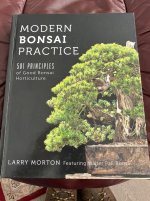I am trying to get a better understanding of how trees use fertilizer and the limits of liquid fertilizer specifically. I tend to understand the cons of over-fertilizing (perhaps incorrectly) as basically salt buildup in the soil. But what if one could thoroughly wash out the liquid fertilizer at each watering - could they then fertilize at each watering? Or is it more than just the salt buildup in the soil and that the trees are actually adversely affected by (or simply cannot take up) the constant supply of nutrients? It's hard to tell what's going on in the soil, but I would guess that the liquid fert is washed out of the soil after 2 or 3 waterings (again, could be wrong). If so, why not fertilize more often with trees in development?
You are using an out of date browser. It may not display this or other websites correctly.
You should upgrade or use an alternative browser.
You should upgrade or use an alternative browser.
(Over)Fertilizing Question
- Thread starter dbonsaiw
- Start date
cmeg1
Imperial Masterpiece
In volcanic aggregate …….ro water = more room for less salt…since water is pure and empty of it………then add minerals and npk .same effectiveness & much less salt ion in a pure ro or rain……can ro for $150 on amazon(hydrologic ro filters).
Ph it…..so its effective……..essential in volcanic aggregate…….also nutrients every watering are essential as pure water will draw the minerals out of the roots in volcanic aggregate
Ph it…..so its effective……..essential in volcanic aggregate…….also nutrients every watering are essential as pure water will draw the minerals out of the roots in volcanic aggregate
Wires_Guy_wires
Imperial Masterpiece
Osmosis and osmotic pressure are things you want to look into when talking nutrients.
In essence, it's the study of solutes (not just salts, also sugars, peptides and others) and their effect on inner and out cell wall pressure.
Once the osmotic pressure becomes too high or too low, cells burst and become damaged beyond repair.
I think the wikipedia pages about osmosis provide you what you're looking for. Turgor pressure and vapor pressure deficit are related terms that also can provide some more in depth insight when talking about vascular systems in plants.
In essence, it's the study of solutes (not just salts, also sugars, peptides and others) and their effect on inner and out cell wall pressure.
Once the osmotic pressure becomes too high or too low, cells burst and become damaged beyond repair.
I think the wikipedia pages about osmosis provide you what you're looking for. Turgor pressure and vapor pressure deficit are related terms that also can provide some more in depth insight when talking about vascular systems in plants.
River's Edge
Masterpiece
For those wishing to dive down this particular rabbit hole I would suggest two authors to help navigate the twists and turns. This is one time when reference material becomes valuable as one considers and reconsiders the explanations and research. Modern Bonsai Practice by Larry Morton, in particular the chapter on understanding fertilizers. ( published 2016) and one of my favourite Bonsai resources Bonsai Heresy by Michael Hagedorn. In particular the sections on fertilization and growth enhancers. ( published 2020)I am trying to get a better understanding of how trees use fertilizer and the limits of liquid fertilizer specifically.


These are going on my gift list.For those wishing to dive down this particular rabbit hole I would suggest two authors to help navigate the twists and turns.
River's Edge
Masterpiece
It would be difficult to try and focus a discussion on a question containing so many variables. The nature of the soil, the method of watering, frequency of watering, concentration of fertilizer, whether the fertilizer actually has elements in a form available to the plant.Or is it more than just the salt buildup in the soil and that the trees are actually adversely affected by (or simply cannot take up) the constant supply of nutrients? It's hard to tell what's going on in the soil, but I would guess that the liquid fert is washed out of the soil after 2 or 3 waterings (again, could be wrong). If so, why not fertilize more often with trees in development?
And just for the record, fertilization patterns should change with stage of development and refinement. Simple things like knowing when seedlings. developing roots can use fertilization and what works best. Growers often benefit from heavier fertilization with developing trees provided the development process is adapted to suit the changing care routine.
Important topic for those wishing to improve their Bonsai practice and trees. The two books I referenced are excellent starting points to ensure a basic understanding that will allow you to evaluate the plethora of advice offered in a forum setting.
Fair point. What specifically got me thinking about this again were my vachelia which seem to visibly grow every time I fertilize. The soil is 80% inorganic (pumice and calcined clay) with 20% pine bark and it gets watered about every two days. The trees are in my basement now and I need to use a watering can (and collect/dispose of the runoff). My watering can will empty fairly quickly (I need to get a new one) and so each tree gets 2 gallons of water at a time. Seems like overkill on the watering to me, but at the same time I started thinking about the fert being washed away. I will fertilize every third watering - about once a week. The trees are exploding with growth and I was just wondering if I could push the growth even harder by fertilizing every 2 waterings instead.It would be difficult to try and focus a discussion on a question containing so many variables. The nature of the soil, the method of watering, frequency of watering, concentration of fertilizer, whether the fertilizer actually has elements in a form available to the plant.
Personally, I would not try this with a more water retentive soil as I question my ability to actually wash out the fert well enough.
River's Edge
Masterpiece
The questions I would consider are what do you hope to accomplish by increasing the growth rate? Do you understand the implications with this particular species? Will it give more satisfactory developmental results or create issue's that make design and care more difficult, once again a lot of variables.Fair point. What specifically got me thinking about this again were my vachelia which seem to visibly grow every time I fertilize. The soil is 80% inorganic (pumice and calcined clay) with 20% pine bark and it gets watered about every two days. The trees are in my basement now and I need to use a watering can (and collect/dispose of the runoff). My watering can will empty fairly quickly (I need to get a new one) and so each tree gets 2 gallons of water at a time. Seems like overkill on the watering to me, but at the same time I started thinking about the fert being washed away. I will fertilize every third watering - about once a week. The trees are exploding with growth and I was just wondering if I could push the growth even harder by fertilizing every 2 waterings instead.
Personally, I would not try this with a more water retentive soil as I question my ability to actually wash out the fert well enough.
Someone with experience with that species and having attempted the variations in fertilizer may be able to give a more informed response. However, it still depends on the specifics in your situation and a personal decision as to your intended outcomes.
If you have several plants, by all means experiment with frequency and outcomes. We are all learning as we go!
